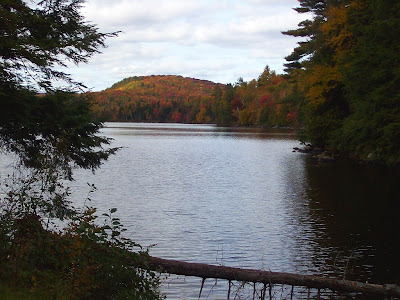Wednesday, October 7, 2009
47 degrees here on the mountain at almost 8 PM. My new toy, an inexpensive anemometer, is spinning at 3 mph with gusts to 5 mph as the front moves in. The rain continues on and off and the "on" part this afternoon disrupted my wood splitting. I coaxed Gail to ride with me for a few minutes while I took some quick pictures, knowing that more rain and wind would influence what is by far the best foliage color in recent years. My ulterior motive was I wanted help picking out some more flat and colorful leaves to add to a collection and a book going to my grandsons out Seattle way. Gail agreed with getting out but had a brief self-debate about taking Karl the Wonder Dog along..... until I let out an impatient "Let's go!" Karl stayed home to snooze on.
During the past few weeks I have probably told a hundred people about the back road to Osmore Pond in the Groton State Forest. The road is almost two miles from our house and the state park people always open it up the day after Labor Day. Since 1989 I have been telling people this as it means not having to pay to get in to see and paddle on a nice little pond. There's also some unusual feeling about a secretive entrance to something so beautiful as Osmore Pond....kind of like an explorer finding something new and exciting.
Gail and I arrived at the road and the gate was locked tight. I muttered some anti budget cut comments and we turned around and headed to New Discovery, the main entrance to Osmore. Karen, one of the rangers, was in the contact station and she explained that they closed the road due to the bad behavior of a few. Just the same the pond was accessible and entrance was free but access is through this entrance. Down the road through a nice maple forest we went.

Osmore Pond has a history I will study some day but I know there was a time when logging around it was an important thing. Several people have told me about two different sawmills on the pond but I have never received good accounts of where the milled lumber went from there.
Osmore has three primitive lean-tos for rent and one newer one on the side close to the parking lot. "Primitive" means you walk in or paddle across the pond. No shower and you share the outhouse with the porcupines. This pond always has had loons but today they were either underwater and out of sight or just not there. The pond is beautiful this time of year so I took a couple shots. Click to enlarge.


We turned around and headed for Owls Head. This is a great granite dome and on a clear day you can see for a hundred miles each way. In late August you might witness raptors moving along as you sit up top eating wild blueberries. In contrast, in late May around Memorial Day you will certainly find other raptors gliding around feeding in the company of slow flying-coasting turkey vultures.

Today the rain was coming down stronger as we made it to the Owls Head parking area. We walked over to the picnic area and I took pictures of Kettle Pond down below. I wish they'd get the work crew to clean out the brush so the view for aging picture takers like me was easier. Typically Camel's Hump is easy to see but from this grown over vantage point, it was missing today.

During the Civilian Conservation Corp days the workers build a set of steps to the top of the mountain. If you have visited here before you know that they are high steps but just the same a fifteen minute walk to the top is nothing in trade for such a beautiful panorama. We want to get back there this weekend as the park staff close Owls Head right after Columbus Day.

Kettle Pond (last 3 shots) is down Route 232 a little further than the Owls Head turn and it's en route to Route 302 that heads to Groton or Orange. There's a prominent parking lot and a portage that's longer than I like if you want to paddle. There is a private youth group area of multiple lean-tos for rent by families, groups like scouts, even an organization of knitters makes a go of it--all who can enjoy a beautiful pond and a rural setting for a few bucks.
We've come to learn this area as it's really part of the big backyard we share. My favorite time is around Memorial Day when wildflowers abound. Trillium and orchids are favorites for me but there are dozens of flowers and shrubs to enjoy. Any time I walk here, I recall ever flower I have found, every place I have taken pictures. Gardeners should think broadly about their gardens and their state as they visit natural areas preserved for our use. Before we decided to move our nursery, I was just starting to lay out some woodland gardens intended to link nature, cultivated wildflowers and domestic hybrids. Maybe sometime I'll get back to that project. For now I can look back at these pictures and be thankful it was such a colorful day. Come visit soon if you can!
Writing from the mountain above Peacham Pond where the wind speed is up to a constant 7 mph and I can hear the trees rustling from my office.
George Africa
The Vermont Gardener















































